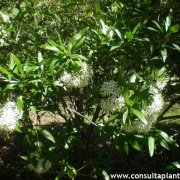Care of the shrub Pavetta lanceolata or Bridal bush |
|
The genus Pavetta, family Rubiaceae, includes 300 species of shrubs, trees and subshrubs native to tropical and subtropical regions of Africa and Asia. Some species are: Pavetta lanceolata, Pavetta capensis, Pavetta indica, Pavetta nitidissima, Pavetta linearifolia. Common names: Christmas bush, Weeping bride's bush, Forest bride's bush, Bridal bush. This species is native to South Africa and Mozambique. They are wide evergreen shrubs (sometimes trees) that reach 4 meters (13.12 feet) in height. The leaves are lanceolate in shape, leathery and bright green. The scented and abundant white flowers appear in groups at the ends of the branches. They bloom in summer. They produce berry-shaped fruits first green and then black. Bridal bush is used to create screens, in small groups, as hedges or as isolated specimens. It has a great capacity to fix Nitrogen to the soil so it fertilizes the earth. In its regions of origin it is used as a medicinal plant. Pavetta lanceolata needs an illuminated exposure but without direct sunlight in the hottest hours of the day. It's a tropical plant that do not resist frost. The soil must be well drained and fertile; use a garden substrate with coarse sand, leaf mulch and peat. Planting is done in early spring. When it's young it grows slowly but once established it develops quickly. Water frequently so that the substrate is always slightly damp; wait for the substrate surface to dry. Fertilize with manure or compost in early spring or fall. It's advisable to prune lightly until the second knot at the end of winter. Sometimes Pavetta lanceolata can be attacked by caterpillars. Weeping bride's bush is easily propagated from seed sown in spring or by semi-woody cuttings in spring. |
Images of the shrub Pavetta lanceolata or Bridal bush |
Find plants
Pavetta lanceolata or Bridal bush | Care and Growing
© 2026 FavThemes


